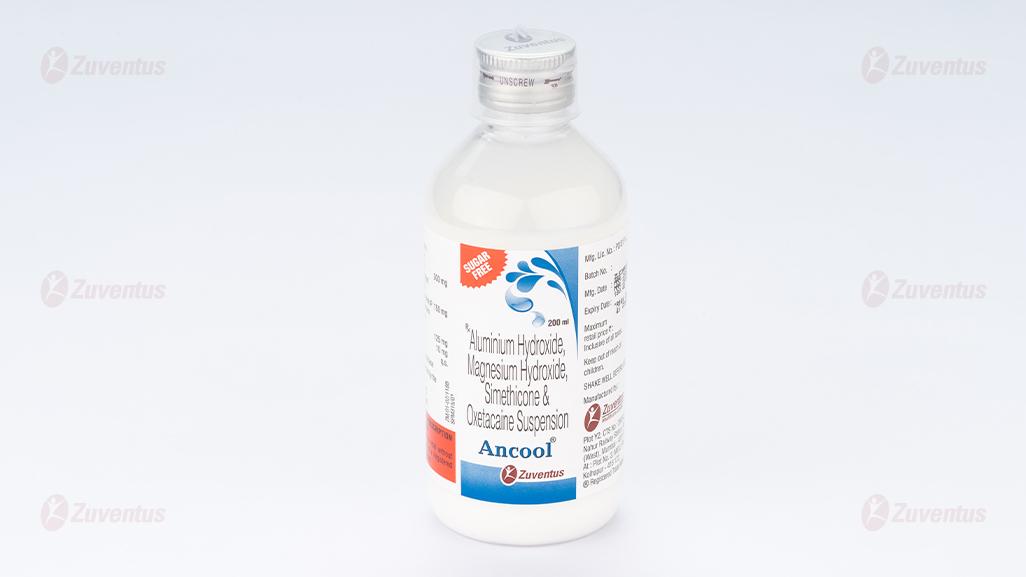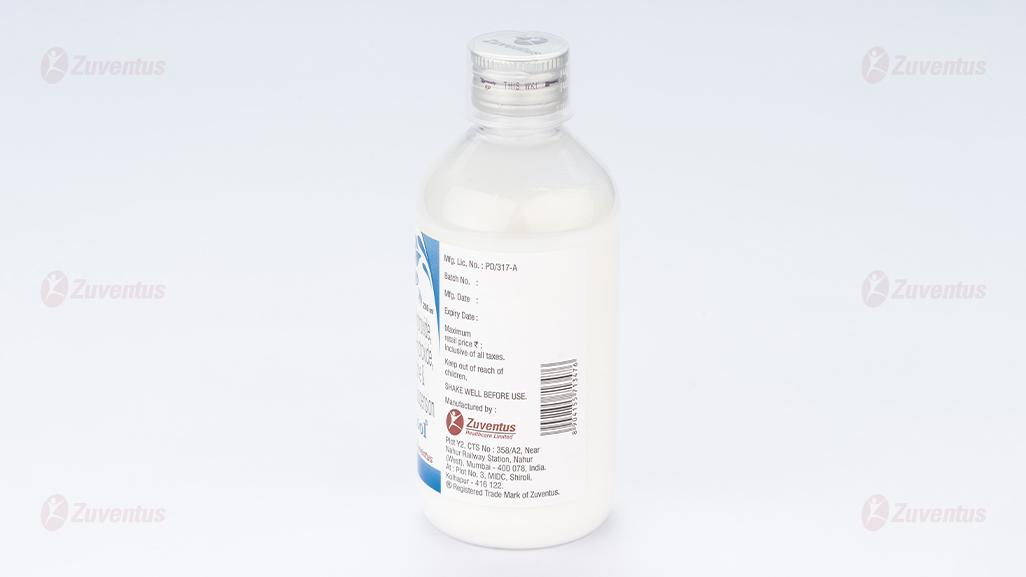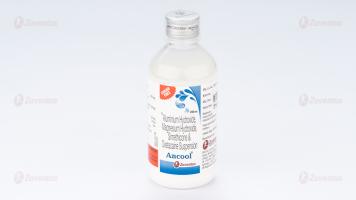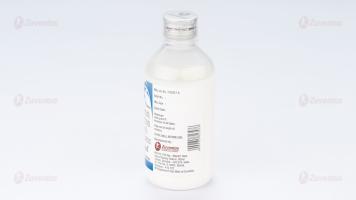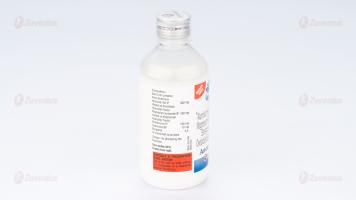Ancool Suspension
Therapy Area
Gastrointestinal
1.0 Generic name
Aluminium Hydroxide, Magnesium Hydroxide, Simethicone & Oxetacaine Suspension
2.0 Qualitative and quantitative composition
Each 5 ml contains:
Dried Aluminium Hydroxide Gel IP 300 mg
(added as Aluminium Hydroxide Paste)
Magnesium Hydroxide IP 150 mg
(added as Magnesium Hydroxide Paste USP)
Simethicone IP 125 mg
Oxetacaine IP 10 mg
Excipients q.s.
In a flavoured syrup base
3.0 Dosage form and strength
Oral Suspension
200 ml bottle
4.0 Clinical particulars
4.1 Therapeutic Indications
Ancool® is indicated for the treatment of symptoms of functional gastrointestinal disorders like irritable bowel syndrome, functional dyspepsia, peptic ulcer, gasteroesophagal reflux disease which include smooth muscle spasms, flatulence, abdominal distension, hyperacidity, gastric distress, bloating etc.
4.2 Posology and method of administration
For oral administration:
Adults
5-10 ml taken 20 minutes to 1 hour after meals and at bedtime or as required.
Children (>5yrs): As an appropriate proportion of the adult dose.
Children under 5 years: Maximum of 5ml three times a day.
Elderly: The normal adult dose is appropriate.
It is preferable to take it undiluted. However, a sip of water may be taken if desired.
4.3 Contraindications
Should not be used in patients who are hypersensitive to any of the active substances or excipients.
Patients are severely debilitated or suffering from kidney failure, or hypophosphataemia.
4.4 Special warnings and precautions for use
Aluminium hydroxide may cause constipation and magnesium salts overdose may cause hypomotility of the bowel; large doses of this product may trigger or aggravate intestinal obstruction and ileus in patients at higher risk such as those with renal impairment, or the elderly.
Aluminium hydroxide is not well absorbed from the gastrointestinal tract, and systemic effects are therefore rare in patients with normal renal function. However, excessive doses or long-term use, or even normal doses in patients with low-phosphorous diets, may lead to phosphate depletion (due to aluminium-phosphate binding) accompanied by increased bone resorption and hypercalciuria with the risk of osteomalacia. Medical advice is recommended in case of long-term use or in patients at risk of phosphate depletion.
In patients with renal impairment, plasma levels of both aluminium and magnesium increase. In these patients, a long-term exposure to high doses of aluminium and magnesium salts may lead to encephalopathy, dementia, microcytic anemia or worsen dialysis-induced osteomalacia.
Aluminium hydroxide may be unsafe in patients with porphyria undergoing hemodialysis. The prolonged use of antacids in patients with renal failure should be avoided.
Pediatric population: In young children the use of magnesium hydroxide can produce a hypermagnesemia, especially if they present renal impairment or dehydration.
If held in the mouth for a long time, Ancool® owing to its oxetacaine content may anesthetize the tongue and impair taste sensation.
4.5 Drug Interactions
Ancool® should not be taken simultaneously with other medicines as they may interfere with their absorption if taken within 1 hour.
Aluminium-containing antacids may prevent the proper absorption of drugs such as tetracyclines, vitamins, ciprofloxacin, ketoconazole, hydroxychloroquine, chloroquine, chlorpromazine, rifampicin, cefdinir, cefpodoxime, levothyroxine, rosuvastatin, H2 antagonists, atenolol, cyclines, diflunisal, digoxin, bisphosphonates, ethambutol, fluoroquinolones, sodium fluoride, glucocorticoids, indomethacin, isoniazid, lincosamides, metoprolol, phenothiazine neuroleptics, penicillamine,propranolol and iron salts.
Levothyroxine may also bind to simeticone which may delay or reduce the absorption of levothyroxine.
Polystyrene sulphonate
Caution is advised when used concomitantly with polystyrene sulphonate due to the potential risks of reduced effectiveness of the resin in binding potassium, of metabolic alkalosis in patients with renal failure (reported with aluminium hydroxide and magnesium hydroxide), and of intestinal obstruction (reported with aluminium hydroxide).
Quinidine:
Concomitant use of aluminium products with quinidines may increase the serum levels of quinidine and lead to quinidine overdosage.
Tetracycline:
Because of the aluminium content, Maalox Plus should not be concomitantly administered with tetracycline-containing antibiotics or any tetracycline salts.
Citrates:
Aluminium hydroxide and citrates may result in increased aluminium levels, especially in patients with renal impairment.
Urine alkalinisation secondary to administration of magnesium hydroxide may modify excretion of some drugs; thus, increased excretion of salicylates has been seen.
4.6 Use in Special Populations
The safety of Ancool® Suspension in pregnancy has not been established.
Pregnancy:
There are no available data on Ancool® use in pregnant women. No conclusions can be drawn regarding whether or not Maalox Plus is safe for use during pregnancy. Ancool® should be used during pregnancy only if the potential benefits to the mother outweigh the potential risks, including those to the fetus.
Lactation:
Because of the limited maternal absorption, when used as recommended, minimal amounts, if any, of aluminium hydroxide and magnesium salt combinations are expected to be excreted into breast milk.
Simeticone is not absorbed from the gastrointestinal tract.
No effect on the breastfed newborn/infant are anticipated since the systemic exposure of the breast-feeding woman to aluminium hydroxide, magnesium hydroxide and simeticone is negligible.
4.7 Effects on ability to drive and use machines
None stated.
4.8 Undesirable effects
The following CIOMS frequency rating is used, when applicable:
Very common (≥ 1/10), common (≥ 1/100 to <1/10), uncommon (≥1/1,000 to <1/100), rare (≥1/10,000 to <1/1,000), very rare (<1/10,000), not known (cannot be estimated from available data).
Immune system disorders
Frequency not known: hypersensitivity reactions, such as pruritus, urticaria, angioedema and anaphylactic reactions
Gastrointestinal disorders
Gastrointestinal side-effects are uncommon. Uncommon: diarrhoea or constipation Frequency not known: Abdominal pain
Injury, poisoning and procedural complications:
Frequency not known: Hyperaluminemia (related to Aluminium component).
Metabolism and nutrition disorders
Very rare: Hypermagnesemia, including observations after prolonged administration of magnesium hydroxide to patients with renal impairment
Frequency not known:
Hyperaluminemia
Hypophosphatemia, in prolonged use or at high doses or even normal doses of the product in patients with low-phosphorus diets which may result in increased bone resorption hypercalciuria, osteomalacia.
Oxetacaine
Glossitis of the hypersensitivity type, dizziness, faintness and drowsiness have occasionally occurred, especially when the recommended dose is exceeded.
Reporting of suspected adverse reactions
- Reporting suspected adverse reactions after authorisation of the medicinal product is important. It allows continued monitoring of the benefit/risk balance of the medicinal product. Healthcare professionals are asked to report any suspected adverse reactions via email to: medico@zuventus.com
- Website: https://www.zuventus.com/drug-safety-reporting
By reporting side effects, you can help provide more information on the safety of this medicine.
4.9 Overdose
Serious symptoms are unlikely following overdosage.
Reported symptoms of acute overdose with aluminium hydroxide and magnesium salts combination include diarrhoea, abdominal pain, vomiting.
Large doses of this product may trigger or aggravate intestinal obstruction and ileus in patients at risk.
Aluminium and magnesium are eliminated through urinary route; treatment of acute overdose consists of administration of IV Calcium Gluconate, rehydration and forced diuresis. In case of renal function deficiency, haemodialysis or peritoneal dialysis is necessary.
5.0 Pharmacological properties
5.1 Mechanism of Action
Dried aluminium hydroxide gel - antacid Magnesium Hydroxide - antacid Simeticone - antifoaming agent/anti-flatulent Oxetacaine: potent gastric mucosal anaesthetic agent The antacids that act by neutralizing the acid in the stomach and by inhibiting pepsin,
which is a proteolytic enzyme.
5.2 Pharmacodynamic properties
Ancool® is a balanced mixture of two antacids, an anti-flatulent/antifoaming agent simeticone and a potent gastric mucosal anaesthetic agent oxetacaine. The two antacids are magnesium hydroxide which is fast acting and aluminium hydroxide which is a slow acting antacid. The combination produces a fast onset of action and an increase in total buffering time. Aluminium hydroxide on its own is an astringent and may cause constipation. This effect is balanced by the effect of the magnesium hydroxide which is in common with other magnesium salts may cause diarrhoea.
Oxetacaine is a potent local anaesthetic agent and provides prompt relief to the pain in acutely inflamed gastric mucosa.
Simethicone is a surfactant that may decrease foaming and hence esophageal reflux. It is included in many antacid preparations for the management of flatulence. Simethicone acts by decreasing the surface tension of gas bubbles, thus facilitating their coalescence and expulsion as flatus or belching. Simethicone facilitates the passage of gas through bowel lumen and allows patients to excrete a greater volume of gas at one time, thereby reducing the number of flatus events. Thus, less residual gas is present to cause uncomfortable or painful pressure in the stomach and intestines.
5.3 Pharmacokinetic Properties
Aluminium hydroxide, when given by mouth most of it remains in the gastrointestinal tract forming insoluble, poorly absorbable aluminium salts such as hydroxide, carbonates and phosphates which are excreted in the feces.
Magnesium hydroxide is a quick acting antacid and its action is for prolonged duration. In the stomach, magnesium hydroxide combines with gastric acid to form magnesium chloride. In the small intestine, magnesium hydroxide is regenerated and excreted in feces. In contrast to almost all other local anaesthetic, oxetacaine ionizes only to a very small extent at a low pH, such as that of gastric acid. Since the anesthetic effect is due to the non-ionized molecules, which are lipid soluble and can penetrate nerve membranes,
oxetacaine maintains its activity even at low pH. Normally oxetacaine when administered alone is absorbed into blood, metabolized in the liver and excreted in the urine. But when given with aluminium and magnesium hydroxide, its absorption is retarded and hence it remains in contact with gastric mucosa for longer time.
In course of time, it mixes with the food and passes into intestine. However, the concentration obtained there is probably so low that no effect is produced on intestinal mucosa.
6.0 Non clinical properties
6.1 Animal toxicology or Pharmacology
Not available
7.0 Description
Pharmacotherapeutic group: Drugs for acid related disorders; Antacids with antiflatulent. Ancool is a combination of Oxetacaine, Aluminium Hydroxide, Magnesium Hydroxide and Simethicone. Oxetacaine is a local anaesthetic agent. Aluminium hydroxide and Magnesium hydroxide are antacids. Simethicone is liquid dimethicone activated with finely divided silicon dioxide to enhance the defoaming properties of the silicone.
8.0 Pharmaceutical particulars
8.1 List of excipients
Carboxymethylcellulose Sodium, Saccharin Sodium, Bronopol, Menthol, Liquid Sorbitol (Non Crystallising), Sodium Citrate, Propylene Glycol, Sorbitan Stearate, Citric Acid Monohydrate, Flavour Coolmints , Glycerol, Polysorbate 20.
8.2 Incompatibilities
Not available
8.3 Shelf life
24 Months
8.4 Packaging information
Bottle PET Transparent [200 ml] with silver cap & measuring cup 10 ml.
8.5 Storage and handling instructions
Store below 30°C, Protected from light. Keep out of reach of children. Shake Well Before Use. Store in tightly closed container and avoid freezing.
9.0 Patient counselling information
If held in the mouth for a long time, Ancool® owing to its oxetacaine content may anesthetize the tongue and impair taste sensation.
Do not take Ancool® Suspension at least 2 hours before or after taking other medicines as it may interact with other medications.
Avoid eating late at night or before bedtime.
Avoid taking Tea, Coffee, Spicy food, and Chocolate.
Avoid alcohol and smoking.
Ancool® Suspension may cause constipation. Drink plenty of water and eat more high-fiber foods. Inform your doctor if it becomes severe or does not go away.
It may take 4-6 weeks or more for the ulcers to heal completely. Do not stop taking the medicine without talking to your doctor first.
It may take 4-6 weeks or more for the ulcers to heal completely. Do not stop taking the medicine without talking to your doctor first.
About leaflet
Read all of this leaflet carefully before you start taking this medicine because it contains important information for you.
- Keep this leaflet. You may need to read it again.
- Ask your pharmacist if you need more information or advice
- You must contact a doctor if your symptoms worsen or do not improve
- If you get any side effects, talk to your doctor or pharmacist. This includes any possible side effects not listed in this leaflet. See section 4.
What is in this leaflet
- What Ancool® is and what it is used for
- What you need to know before you take Ancool®
- How to take Ancool®
- Possible side effects
- How to store Ancool®
- Contents of the pack and other information
1. What Ancool® is and what it is used for
Ancool® contains four different medicines:
- The first two medicines are called dried aluminium hydroxide gel and magnesium hydroxide. They belong to a group of medicines called antacids
- The other medicine is called simeticone. It belongs to a group of medicines called anti-foaming agents
- The 4th medicine is called oxetacaine is a potent local anaesthetic agent and provides prompt relief to the pain due to acidity.
Ancool® is used for:
- The relief of indigestion (dyspepsia)
- Heartburn
- Wind (flatulence)
Ancool® works by lowering the amount of acid in your stomach. The anti-foaming agent in Ancool® helps to remove gas from your stomach. Oxetacaine provides prompt relief of heartburn (pain) due to acidity.
2. What you need to know before you take Ancool®
Do not take Ancool® if:
- You are allergic (hypersensitive) to dried aluminium hydroxide gel, magnesium hydroxide, oxetacaine, simeticone or any of the other ingredients in Ancool®. Signs of an allergic reaction include: a rash, swallowing or breathing problems, swelling of your lips, face, throat or tongue
- You are feeling very weak and have no energy (debilitated)
- You have kidney disease / kidney failure
- You have low levels of phosphate (called ‘hypophosphataemia’). This is shown up in blood tests.
Do not take this medicine if any of the above apply to you. If you are not sure, talk to your doctor or pharmacist before taking Ancool®.
Warnings and precautions
Talk to your doctor before taking Ancool® if:
- You are on a low-phosphorous diet
- You are suffering from porphyria and are undergoing haemodialysis.
Children
In small children use of magnesium hydroxide may cause hypermagnesemia particularly if they have renal impairment or dehydration.
Other medicines and Ancool®
Tell your doctor if you are taking or have recently taken any other medicines.
This includes medicines you buy without a prescription including herbal medicines.
Ancool® should not be taken at the same time as other medicines. This is because Ancool® can affect the way other medicines work. If Ancool® is taken within one hour of any other medicine, it can affect the uptake of that medicine into the blood.
Some medicines may be affected by magnesium hydroxide or they may affect how well magnesium hydroxide will work.
Tell your doctor or pharmacist if you are taking, have recently taken or might take any of the medicines listed below, as some medicines may be affected by Ancool® or they may affect how well Ancool® will work. In particular:
- Medicines used to treat the heart such as quinidine, metoprolol, atenolol and propranolol
- Medicines used to treat anemia such as iron salts
- Medicines used to treat stomach ulcers and acidity such as ranitidine or cimetidine (H2 antagonists)
- Medicines used to treat malaria such as chloroquine
- Medicines used to treat some bone disorders such as bisphosphonates
- Medicines used to treat some allergic, inflammatory or abnormal immune reactions such as glucocorticoids
- Medicines used to treat tuberculosis such as ethambutol, isoniazid
- Medicines used to treat infections such as fluroquinolones, lincosamides, ketoconazole, cyclines including tetracylines, cephalosporins (cefpodoxime & cefdinir)
- Medicines used to treat mental illness (psychosis)such as phenothiazine neuroleptics
- Medicines used to treat increased amounts of potassium in the body such as polystyrene sulfonate
- Medicines used to treat pain such as diflunisal and indomethacin
- Medicines used in dental care such as sodium fluoride
- Medicines used to treat an underactive thyroid gland such as levothyroxine
- Medicines used to treat joint pains and abnormal chemical reactions in the body such as penicillamine
- Medicines used to reduce cholesterol such as rosuvastatin
- Salicylates including aspirin
Pregnancy and breast-feeding
Talk to your doctor or pharmacist before taking this medicine if:
- You are pregnant, might become pregnant, or think you may be pregnant.
- You are breast-feeding or planning to breast-feed
3. How to take Ancool®
Taking this medicine
- Shake well before use
- Take this medicine by mouth
Adults including the elderly
- Take one to two 5 ml spoonfuls 4 times each day
- Take 20 minutes to 1 hour after meals and at bedtime
- Alternatively, take as directed by your doctor
Children aged 12 to 18 years
- Give your child one to two 5 ml spoonfuls 4 times each day
- Give this medicine 20 minutes to 1 hour after meals and at bedtime
- Alternatively, give as directed by your doctor
Children aged 5 to 12 years
- Give your child a maximum of one 5 ml spoonful 3 to 4 times each day
- Give this medicine 20 minutes to 1 hour after meals or at bedtime
- Alternatively, give as directed by your doctor
Children 2 to 5 years old
- Do not give your child more than one 5 ml spoonful three times each day 4
- Give this medicine 20 minutes to 1 hour after meals and at bedtime
- Alternatively, give as directed by your doctor
If the symptoms do not go away, talk to your doctor.
If you take more Ancool® than you should
Talk to your doctor or go to a hospital straight away. Remember to take any medicine that is left with you so the doctor knows what you have taken.
4. Possible side effects
The following effects may happen; diarrhoea, stomach pain or you may get a bloated feeling and cramping pain in the abdomen (stomach), be sick (vomit), have indigestion, heartburn, upset stomach, constipation, loss of appetite, dry mouth. This could be caused by an obstruction or blockage of the bowel (ileus).
Like all medicines, Ancool® can cause side effects, although not everybody gets them.
Stop taking Ancool® and see a doctor or go to a hospital straight away if: Not known (frequency cannot be estimated from the available data)
- You have a red and lumpy skin rash, swollen eyelids, face, lips, mouth or tongue, itching, difficulty breathing or swallowing. This could be an allergic reaction.
Tell your doctor or pharmacist if any of the following side effects get serious or lasts longer than a few days. Also tell them if you notice any side effects not listed in this leaflet:
Uncommon (may affect up to 1 in 100 people)
- Constipation
- Diarrhoea
Very rare (may affect up to 1 in 10,000 people)
- Hypermagnesemia, including observations after prolonged administration to patients with renal impairment.
Not known (frequency cannot be estimated from the available data)
- Hypophosphatemia, this may occur at high doses of the product or even at normal doses especially in patients with low phosphorus diets
- Hyperaluminemia is an electrolyte disturbance in which there is an abnormally elevated level of aluminium in the body
- Abdominal pain
Reporting of side effects
- If you get any side effects, talk to your doctor. This includes any possible side effects not listed in this leaflet. You can also report side effects directly: Website: https://www.zuventus.com/ and click the tab “Safety Reporting” located on the top of the home page.
- By reporting side effects, you can help provide more information on the safety of this medicine.
5. How to store Ancool®
Keep this medicine in a safe place where children cannot see or reach it.
Do not use Ancool® after the expiry date which is stated on the bottle and carton after EXP. The expiry date refers to the last day of that month.
Do not refrigerate or freeze. Store below 30°C.
6. Contents of the pack and other information
What Ancool® contains
Each bottle contains the following active substances in each 5ml of suspension: 300mg of dried aluminium hydroxide gel, 150mg of magnesium hydroxide, 125mg of simeticone and Oxetacaine 10 mg.
What Ancool® looks like and contents of the pack
Ancool® is a white suspension, homogenous after shaking and is available in a PET Transparent [200 ml] bottle with silver cap & measuring cup 10 ml.
Marketing Authorisation Holder and Manufacturer

